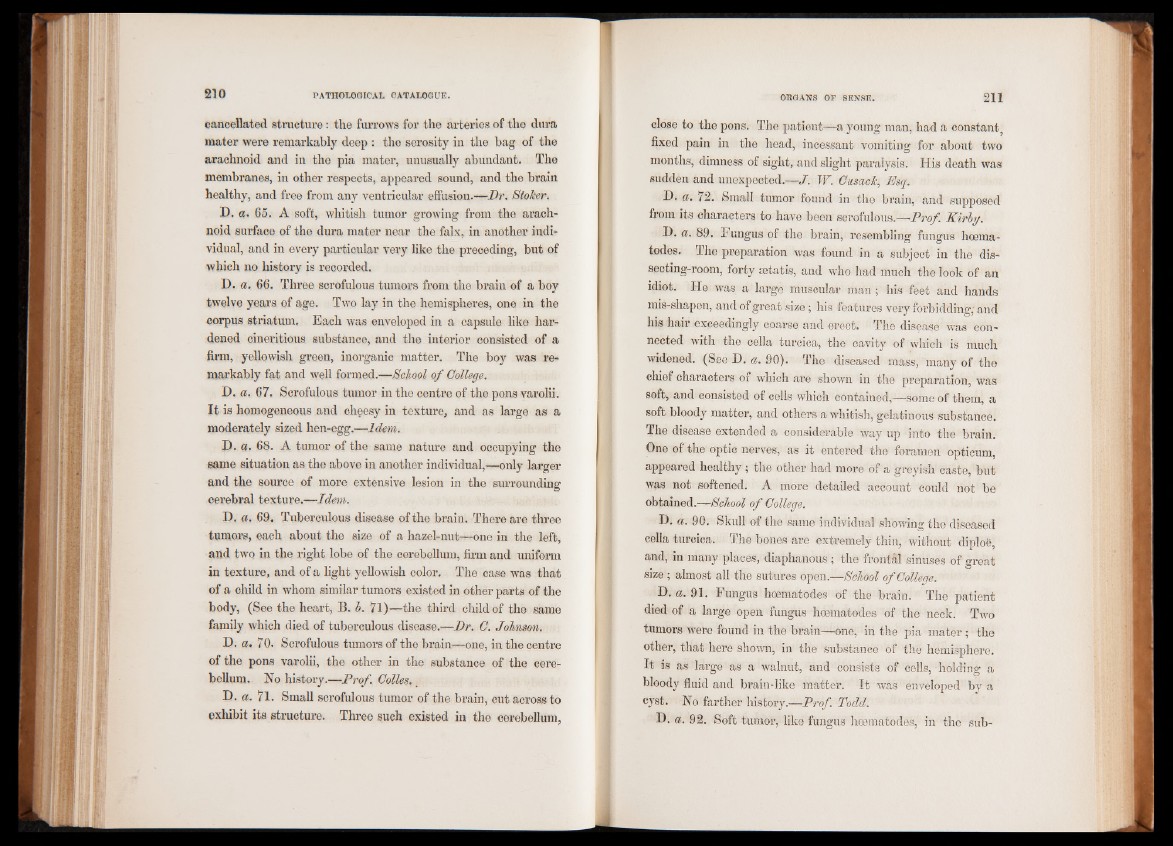
cancellated structure: the furrows for the arteries of the dura
mater were remarkably deep : the serosity in the bag of the
arachnoid and in the pia mater, unusually abundant. The
membranes, in other respects, appeared sound, and the brain
healthy, and free from any ventricular effusion.—Dr. Stoker.
D. a. 65. A soft, whitish tumor growing from the arachnoid
surface of the dura mater near the falx, in another individual,
and in every particular very like the preceding, but of
which no history is recorded.
D. a. 66. Three scrofulous tumors from the brain of a boy
twelve years of age. Two lay in the hemispheres, one in the
corpus striatum. Each was enveloped in a capsule like hardened
cineritious substance, and the interior consisted of a
firm, yellowish green, inorganic matter. The boy was remarkably
fat and well formed.—School of College.
D. a. 67. Scrofulous tumor in the centre of the pons varolii.
It is homogeneous and cheesy in texture, and as large as a
moderately sized hen-egg.—Idem.
I), q. 68. A tumor of the same nature and occupying the
same situation as the above in another individual,—only larger
and the source of more extensive lesion in the surrounding
cerebral texture.—Idem.
D. a. 69. Tuberculous disease of the brain. There are three
tumors, each about the size of a hazel-nut—one in the left,
and two in the right lobe of the cerebellum, firm and uniform
in texture, and of a light yellowish color. The case was that
of a child in whom similar tumors existed in other parts of the
body, (See the heart, B. h. 71)—the third child of the same
family which died of tuberculous disease.—Dr. C. Johnson.
D. a. 70. Scrofulous tumors of the brain—one, in the centre
of the pons varolii, the other in the substance of the cerebellum.
No history.—Prof. Colles.
D. a. 71. Small scrofulous tumor of the brain, cut across to
exhibit its structure. Three such existed in the cerebellum,
close to the pons. The patient—a young man, had a constant,
fixed pain in the head, incessant vomiting for about two
months, dimness of sight, and slight paralysis. His death was
sudden and unexpected.—J. W. CusacJc, Esq.
H. a. /2. Small tumor found in the brain, and supposed
from its characters to have been scrofulous.—Prof. Kirby.
H. a. 89. Fungus of the brain, resembling fungus hcema-
todes. The preparation was found in a subject in the dissecting
room, forty setatis, and who had much the look of an
idiot. He was a large muscular man; his feet and hands
mis-shapen, and of great size; his features very forbidding, and
his hair exceedingly coarse and erect. The disease was connected
with the cella turcica, the cavity of which is much
widened. (See D. a. 90). The diseased mass, many of the
chief characters of which are shown in the preparation, was
soft, and consisted of cells which contained,—some of them, a
soft bloody matter, and others a whitish, gelatinous substance.
The disease extended a considerable way up into the brain.
One of the optic nerves, as it entered the foramen opticum,
appeared healthy; the other had more of a greyish caste, but
was not softened. A more detailed account could not be
obtained.—School of College.
D. a. 90. Skull of the same individual showing the diseased
cella turcica. The bones are extremely thin, without diploe,
and, in many places, diaphanous ; the frontal sinuses of great
size ; almost all the sutures open.—School of College.
D. a. 91. Fungus hoematodes of the brain. The patient
died of a large open fungus hoematodes of the neck. Two
tumors were found in the brain—one, in the pia mater ; the
other, that here shown, in the substance of the hemisphere.
It is as large as a walnut, and consists of cells, holding a
bloody fluid and brain-like matter. It wras enveloped by a
cyst. No farther history.—Prof. Todd.
D. a. 92. Soft tumor, like fungus hoematodes, in the sub